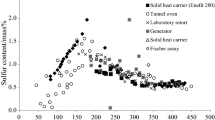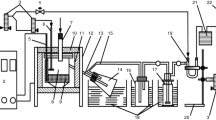Abstract
Shengli crude oil sample was investigated using a comprehensive method to characterize and identify the formation and distribution of the organic sulfide. A full compositional model uses an autoclave on the system of Shengli crude oil and magnesium sulfate under high temperature and pressure conditions. Gas chromatography (GC) and microcoulometry were used to describe characteristics of gas phase products. The results show that the ratio of methane in the gas composition and the content of hydrogen sulfide improved by increasing temperature, which suggested that with the reaction temperature growing, the extent of the thermochemical sulfate reduction (TSR) process is deepened gradually. With the analysis of oil phase products by fourier transform ion cyclotron resonance mass spectrometry (FT-ICR MS) and gas chromatography-pulsed-flame photometric detector (GC-PFPD), the distribution of organic sulfide can be detected in detail. The contents of organic sulfide especially as mercaptan, sulfoether and thiophene were detected by GC-PFPD. Through FT-ICR MS, sulfide species were characterized by class, type, and carbon number. The results show that, with increasing temperature, the content of mercaptan, became dramatically dominated, sulfoether and thiophene gradually increasing too. Types of sulfur compounds in the oil phase identified by FT-ICR MS are mainly S1, S2, N1S1, O1S1 and O2S1. The S1 species are the most dominated. All of the results suggest that, as the reaction temperature is growing, the evolution process of organic sulfur compounds is originally changed from thiophene series to the benzothiophene series gradually and then to dibenzothiophene series. The products of solid phases were analyzed by FT-IR and XRD. The results show that the content of sulphur in magnesium sulphate decreased. This fenomenon demonstrated transformation of inorganic sulfur compounds into organic sulfur compound. According to the reaction model, the calculated activation energy is 57.91 kJ mol−1 and the frequency factor A is 0.21 s−1.
Similar content being viewed by others
References
W. G. Toland, “Oxidation of organic compounds with aqueous sulfate,” J Am. Chem. Soc. 82, 1911–1916 (1960).
W. L. Orr, “Changes in sulfur content and isotope ratios of sulfur during petroleum maturation study of Big Horn basin Paleozoic oils,” Am. Assoc. Pet Geol. Bull. 58, 2295–2318 (1974).
W. L. Orr, “Geologic and geochemical controls on the distribution of hydrogen sulfide in natural gas,” in Advances in Organic Geochemistry, Ed. by R. Campos and J. Goni (Pergamon Press, Oxford, 1977) pp. 571–597.
R. Sassen and C. H. Moore, “Framework of hydrocarbon generation and destruction in eastern Smackover Trend,” Am. Assoc. Pet Geol Bull., 72, 649–663 (1988).
Y. Kiyosu and H. R. Krouse, “Carbon isotope effect during abiogenic oxi-dation of methane,” Earth Planet. Sci. Lett. 95, 302–306 (1989).
H. G. Machel, H. R. Krouse, and R. Sassen, “Products and distinguishing criteria of bacterial and thermochemical sulfate reduction,” Appl Geochem. 10, 373–389 (1995).
R. H. Worden, P. C. Smalley, and N. H. Oxtoby, “Gas souring by thermochemical sulfate reduction at 140°C,” Am. Assoc. Pet. Geol. Bull. 79, 854–863 (1995).
H. G. Machel, “Gas souring by thermochemical sulfate reduction at 140?: discussion,” Am. Assoc. Pet. Geol. Bull. 82, 1870–1873 (1998).
Y. G. Wang, L. R. Dou, Y. C. Wen, et al., “Origin of H2S in Triassic Feixianguan Formation gas pools, Northeastern Sichuan Basin, China,” Geochimica (in Chinese), 31, 517–524 (2002).
C. F. Cai, R. H. Worden, S. H. Bottrell, et al., “Thermochemical sulphate reduction and the generation of hydrogen sulphide and thiols (mercaptans) in Triassic carbonate reservoirs from the Sichuan Basin, China,” Chem Geol 202, 39–57 (2003).
M. M. Cross, D. A. C. Manning, S. H. Bottrell, et al., “Thermochemical sulphate reduction (TSR): experimental determination of reaction kinetics and implications of the observed reaction rates for petroleum reservoirs,” Org Geochem. 35, 393–404 (2004).
H. Y. Dhannoun and W. S. Fyfe, “Reaction rates of hydrocarbons with an hydrite,” Progr. Exp. Petrol. 2, 69–71 (1972).
Y. Kiyosu, “Chemical reduction and sulfur-isotope effects of sulfate organic matter under hydrothermal conditions,” Chem Geol. 30, 47–56 (1980).
P. A. Trudinger, L. A. Chambers, and J. W. Smith, “Low temperature sulphate reduction: biological versus abiological,” Can J. Earth Sci. 22, 1910–1918 (1985).
Y. Kiyosu and H. R. Krouse, “The role of organic-acid in the abiogenic reduction of sulfate and the sulfur isotope effect,” Geochem J. 24, 21–27 (1990).
Y. Kiyosu, H. R. Krouse, “Thermochemical reduction and sulfur isotopic behavior of sulfate by acetic-acid in the presence of native sulfur,” Geochem. J. 27,49 (1993).
G. G. Hoffmann, I. Steinfatt, “Thermochemical sulfate reduction at steam flooding processes–a chemical approach,” in Proceedings of the 205th ACS National Meeting Enhanced Oil Recovery Symposium Proceedings 38 (American Chemical Society, Washington, 1993), pp. 181–184.
M. B. Goldhaber and W. L. Orr, “Kinetic controls on thermochemical sulfate reduction as a source of sedimentary H2S,” in: Geochemical Transformations of Sedimentary Sulfur. ACS Symposium Series 612, Ed. by M. A Vairavamurthy, and M.A.A. Schoonen, (American Chemical Society, Washington, 1995), pp. 412–425.
C. C. Pan, L. P. Yu, J. Z. Liu, et al., “Chemical and carbon isotopic fractionations of gaseous hydrocarbons during abiogenic oxidation,” Earth Planet Sci. Lett. 246, 70–89 (2006).
C. F. Cai and H. T. Li, “Thermochemical sulfate reduction in sedimentary basins: a review,” Adv Earth Sci. 20, 1100–1105 (2005) [in Chinese].
C. T. Yue, S. Y. Li, K. L. Ding, et al., “Study of simulation experiments on the TSR system and its effect on the natural gas destruction,” Sci. China Ser. D-Earth Sci. 48, 1197–1202 (2005).
C. T. Yue, S. Y. Li, K. L. Ding, et al., “Thermodynamics and kinetics of reactions between C1–C3 hydrocarbons calcium sulfate in deep carbonate reservoirs,” Geochem J. 40, 87–94 (2006).
P. Liu, C. Xu, Q. Shi, et al., “Characterization of sulfide compounds in petroleum: Selective oxidation followed by positive-ion electrospray Fourier transform ion cyclotron resonance mass spectrometry,” Anal. Chem. 82 (15), 6601–6606 (2010).
H. Muller, J. T. Andersson, and W. Schrader, “Characterization of high-molecular-weight sulfur-containing aromatics in vacuum residues using Fourier transform ion cyclotron resonance mass spectrometry,” Anal. Chem. 77 (8), 2536–2543 (2005).
J. M. Purcell, P. Juyal, D. G. Kim, et al., Energy Fuels, 21 (5), 2869–2874 (2007).
S. K. Panda, W. Schrader, and J. T. Andersson, “Fourier transform ion cyclotron resonance mass spectrometry in the speciation of high molecular weight sulfur heterocycles in vacuum gas oils of different boiling ranges,” Anal. Bioanal. Chem. 392 (5), 839–848 (2008).
S. K. Panda, J. T. Andersson, and W. Schrader, “Characterization of supercomplex crude oil mixtures: What is really in there?” Angew Chem. Int. Ed. 48, 1788–1791 (2009).
J. M. Purcell, P. Juyal, D. G. Kim, et al., “Sulfur speciation in petroleum: atmospheric pressure photoionization or chemical derivatization and electrospray ionization Fourier transform ion cyclotron resonance mass spectrometry,” Energy Fuels 21 (5), 2869–2874 (2007).
W. Schrader, S. K. Panda, K. J. Brockmann, et al., “Characterization of non-polar aromatic hydrocarbons in crude oil using atmospheric pressure laser ionization and Fourier transform ion cyclotron resonance mass spectrometry (APLI FT-ICR MS),” Analyst 133, 867–869 (2008).
A. A. Al-Hajji, H. Muller, and O. R. Koseoglu, “Characterization of nitrogen and sulfur compounds in hydrocracking feedstocks by Fourier transform ion cyclotron mass spectrometry,” Oil Gas Sci. Technol. 63, 115–128 (2008).
H. Muller, J. T. Andersson, W. Schrader, “Characterization of high-molecular-weight sulfur-containing aromatics in vacuum residues using Fourier transform ion cyclotron resonance mass spectrometry,” Anal. Chem. 77 (8), 2536–2543 (2005).
S. K.Panda, W. Schrader, J. T. Andersson, “Fourier transform ion cyclotron resonance mass spectrometry in the speciation of high molecular weight sulfur heterocycles in vacuum gas oils of different boiling ranges,” Anal. Bioanal. Chem. 392 (5), 839–848 (2008).
Q. Shi, N. Pan, P. Liu, et al., “Characterization of sulfur compounds in oilsands bitumen by methylation followed by positive-ion electrospray ionization and Fourier transform ion cyclotron resonance mass spectrometry,” Energy Fuels 24 (5), 3014–3019 (2010).
N. Pan, Q. Shi, C. M. Xu, P. Liu, et al., “Synthesis and Characterization of methylsulfonium salt in diesel fraction using electrospray ionization Fourier transform ion cyclotron resonance mass spectrometry,” Chinese J. Anal. Chem. 38 (3), 413–416 (2010).
K. L. Ding, S. Y. Li, C. T. Yue, “A simulation on the formation of organic sulfurcompounds in petroleum from thermochemical sulfate reduction,” J. Fuel Chem. Technol. 36 (1), 48–54 (2008).
S. Y. Li, K. L. Ding, C. T. Yue, et al., “Simulation experiments on TSR system of n-hexane and magnesium sulphate in presence of water,” J. China Univ. Petrol. 33 (1), 120–126 (2009).
T. S. Chen, Q. He, H. Lu, “Thermal simulation experiments of saturated hydrocarbons with calcium sulfate and element sulfate: implications on origin of H2S,” Sci. China Ser. D: Earth Sci. 39 (12), 1701–1708 (2009).
M. C. Martin and A. C. David, “Thermochemical sulphate reduction (TSR) experimental determination of reaction kinetics and implications of the observed reaction rates for petroleum reservoirs,” Org. Geochem. 35, 393–404 (2004).
H. G. Machel, H. R. Krouse, and R. Sassen, “Products and distinguishing criteria of bacterial and thermochemical sulfate reduction, Appl. Geochem. 10, 373–389 (1995).
L. Wen, W. X. Liang, Z. G. Zhang, et al., The Infrared Spectroscopy of Minerals (Chongqing University Press, Chongqing, 1989), pp. 55–65.
M. Svetozar, D. Durdica, M. Miroslava, et al., “Influence of chemical synthesis on the crystallization and properties of zinc oxide,” Mater. Chem. Phys. 77, 521–530 (2002).
X. H. Wang, Y. M. Du, and H. Liu, “Preparation, characterization and antimicrobial activity of chitosan-Zn complex,” Carbohydr. Polym. 56, 21–26 (2004).
Author information
Authors and Affiliations
Corresponding author
Additional information
The article is published in the original.
Rights and permissions
About this article
Cite this article
Yue, C.T., Li, S.Y. & Song, H. Simulation experiments on the generation of organic sulfide in the Shengli crude oil. Geochem. Int. 53, 1052–1063 (2015). https://doi.org/10.1134/S0016702915120113
Received:
Accepted:
Published:
Issue Date:
DOI: https://doi.org/10.1134/S0016702915120113




